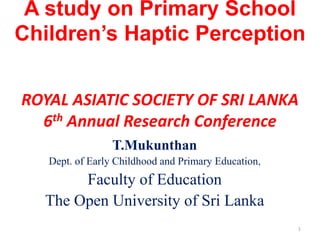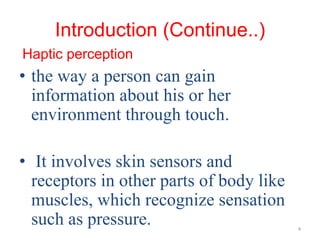A study on Primary School ChildrenŌĆÖs Haptic Perception
- 1. A study on Primary School ChildrenŌĆÖs Haptic Perception ROYAL ASIATIC SOCIETY OF SRI LANKA 6th Annual Research Conference T.Mukunthan Dept. of Early Childhood and Primary Education, Faculty of Education The Open University of Sri Lanka 1
- 2. Outline ŌĆó Introduction ŌĆó Research problem ŌĆó Methodology ŌĆó Findings and Discussion 2
- 3. Introduction PERCEPTION ŌĆśPerception is the knowledge of objects resulting from direct contact with themŌĆÖ. -Jean Piaget (1948) 3
- 4. Introduction (Continue..) Haptic perception ŌĆó the way a person can gain information about his or her environment through touch. ŌĆó It involves skin sensors and receptors in other parts of body like muscles, which recognize sensation such as pressure. 4
- 5. Introduction (Continue..) ŌĆó These work together to send signals to the brain, which interprets them to form a representation of the environment for the person to understand. 5
- 6. ŌĆó Psychologist Jean Piaget conducted study about childrenŌĆÖs haptic perception. ŌĆó He noted that, ŌĆśŌĆ”with stage II we encounter the beginning of recognition of eucliden shapes, based on distinction between straight and curved lines, angles different sizes, parallels and especilly on relations between equal or unequal sides of figuresŌĆ” 6
- 7. Research Problem ŌĆó Jean PiagetŌĆÖs Cognitive Development Theory is one of the theories which has tremendously influenced pre-school curriculum worldwide (Case 1993, Dockett, 1995) and Piagetian perspective is very relevant in teaching mathematics in the primary school today (Kamii, 2004) 7
- 8. The idea of hapitic perceptions also included in the Pre-School and primary mathematics syllbi. the present study has attempted to identify applicability of childrenŌĆÖs haptic presented in his theory to Sri Lankan Context. 8
- 9. Methodology- SAMPLE age Boys Girls 6 Years 15 15 7 Years 16 16 Total 31 31 9
- 10. Methodology Instrument The similar instrument which Jean Piaget used his experiment used in this study. Child was placed before a screen behind which it feels objects handed to it. 10
- 11. ŌĆó By following this procedure rather than the conventional one of placing objects beneath a table, the experimenter can see the methods of tactile exploration employed, knowledge of which is vital to the study of the results. 11
- 12. 12
- 13. Following objects were given to the child. (i). Common Objects (ii). cardboard cut-outs of Geometrical shapes 13
- 14. Common Objects 14
- 15. cardboard cut-outs of Geometrical shapes A. Simple and symmetrical B. More complex but also symmetrical C. Asymmetrical but with straight sides D. a number of purely topological forms 15
- 16. cardboard cut-outs of Geometrical shapes (A) Simple and symmetrical Circle, ellipse, square, rectangle, rhombus, triangle and cross 16
- 17. (B). More complex but also symmetrical (B). More complex but also symmetrical Star, cross of Lorraine, swastika, simple semi circle and semi circle with notches along the chord 17
- 18. (C) Asymmetrical but with straight sides trapezoids with various sides 18
- 19. (D). a number of purely topological forms irregular surfaces pierced one or two holes, Open or closed rings and two intertwined rings. 19
- 20. Findings OBJECTS PERCENTAGES Common Objects 95% A. Simple and symmetrical 75% B. More complex but also symmetrical 67% C. Asymmetrical but with straight sides 55% 48% D. a number of purely topological forms 20
- 21. Findings ŌĆó Most of the children in 6 can identify the common objects easily ŌĆó ,54% of children identify the simple and symmetry geometry shapes, ŌĆó 41% those identify More complex but also symmetrical of geometrical shapes and only ŌĆó 5% identify Asymmetrical but with straight sides: trapezoids with various sides type geometrical shapes ŌĆó nobody could not identify ) a number of purely topological forms. 21
- 22. Summary ŌĆó Introduction ŌĆó Research problem ŌĆó Methodology ŌĆó Findings and Discussion 22
- 23. THANK YOU 23























